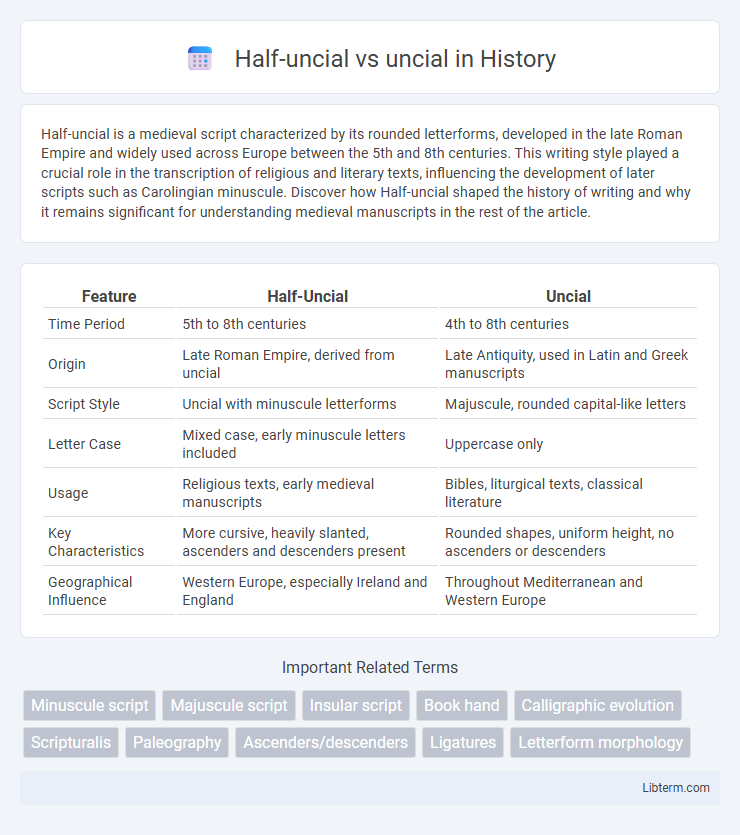Half-uncial is a medieval script characterized by its rounded letterforms, developed in the late Roman Empire and widely used across Europe between the 5th and 8th centuries. This writing style played a crucial role in the transcription of religious and literary texts, influencing the development of later scripts such as Carolingian minuscule. Discover how Half-uncial shaped the history of writing and why it remains significant for understanding medieval manuscripts in the rest of the article.
Table of Comparison
| Feature | Half-Uncial | Uncial |
|---|---|---|
| Time Period | 5th to 8th centuries | 4th to 8th centuries |
| Origin | Late Roman Empire, derived from uncial | Late Antiquity, used in Latin and Greek manuscripts |
| Script Style | Uncial with minuscule letterforms | Majuscule, rounded capital-like letters |
| Letter Case | Mixed case, early minuscule letters included | Uppercase only |
| Usage | Religious texts, early medieval manuscripts | Bibles, liturgical texts, classical literature |
| Key Characteristics | More cursive, heavily slanted, ascenders and descenders present | Rounded shapes, uniform height, no ascenders or descenders |
| Geographical Influence | Western Europe, especially Ireland and England | Throughout Mediterranean and Western Europe |
Introduction to Uncial and Half-Uncial Scripts
Uncial script, developed in the 4th century, is characterized by rounded, majuscule letters used primarily in Latin and Greek manuscripts, serving as the standard book hand of late antiquity and the early medieval period. Half-uncial emerged around the 5th century as a more compact, minuscule script blending capital and lowercase letterforms, facilitating faster writing and greater differentiation between letters. These scripts collectively influenced the evolution of medieval calligraphy, with uncial emphasizing formal, luxurious manuscripts and half-uncial promoting efficiency and readability in monastic scriptoria.
Historical Origins of Uncial Script
Uncial script originated in the 4th century AD as a rounded, majuscule writing style used primarily for Latin and Greek manuscripts, evolving from earlier Roman capital scripts to accommodate faster writing and readability. Half-uncial emerged in the 5th century as a derivative, featuring more lowercase characteristics and increased use of ascenders and descenders, making it more suitable for general manuscript copying. Both scripts played crucial roles in medieval book production, with uncial dominating religious texts and half-uncial facilitating the transition towards minuscule scripts.
The Emergence of Half-Uncial Writing
Half-uncial writing emerged in the 4th century as a more rounded and simplified variant of the older uncial script, facilitating faster writing and increased legibility. Unlike the larger and more formal uncial letters used primarily for religious manuscripts, half-uncial introduced greater differentiation between letterforms, including distinct ascenders and descenders. This innovation significantly influenced the development of later medieval scripts, bridging classical and medieval paleography.
Key Visual Differences: Uncial vs Half-Uncial
Uncial script features rounded, uniform letterforms with minimal ascenders and descenders, while Half-uncial presents more varied shapes and pronounced ascenders and descenders, making it slightly more angular and cursive. Uncial letters are typically larger and more open, designed for monumental inscriptions, whereas Half-uncial is smaller, refined, and suited for everyday manuscript writing. The distinct "a" in Half-uncial, resembling the modern lowercase "a," contrasts with the more simplified Uncial "a," highlighting a key visual difference between the two scripts.
Letterform Analysis: Shape and Structure
Half-uncial letterforms exhibit more angular and compact shapes compared to the rounded and broad strokes of uncial scripts, reflecting a transitional adaptation in medieval manuscript design. Uncial letters are characterized by their uniform, curved lines with minimal pen lifts, creating a smooth, flowing appearance, whereas half-uncial introduces distinct ascenders and descenders, enhancing legibility and dynamic structure. The structural evolution from uncial to half-uncial demonstrates a shift toward greater efficiency in writing, with half-uncial showing refined proportions and more varied letter shapes.
Usage and Function in Medieval Manuscripts
Half-uncial was primarily used for everyday writing and educational texts in medieval manuscripts, characterized by its more rounded and simplified letterforms that allowed faster handwriting. Uncial, with its larger, more formal and rounded letters, served mainly for religious and ceremonial manuscripts, emphasizing legibility and grandeur on costly parchment. The functional distinction in usage reflects their respective roles: half-uncial for practical documentation and uncial for prestigious literary and liturgical works.
Regional Variations and Spread Across Europe
Half-uncial and uncial scripts exhibit distinct regional variations, with uncial primarily prevalent in Mediterranean regions such as Italy and Spain, while half-uncial gained prominence in Ireland and Anglo-Saxon England. The uncial script, characterized by rounded letters, spread mainly through Latin manuscripts used in ecclesiastical contexts across southern Europe. Half-uncial's more compact and angular letterforms facilitated its adoption in northern Europe, influencing manuscript traditions in monasteries and shaping the development of later medieval scripts.
Influence on Later Calligraphic Styles
Half-uncial, characterized by more rounded and accessible letterforms, significantly influenced the development of Carolingian minuscule, which became the standard script in medieval Europe, promoting legibility and uniformity. Uncial, with its majuscule, rounded shapes, impacted the design of early medieval manuscripts and influenced later uncial revivals in the Renaissance, emphasizing monumental and decorative qualities. Both scripts contributed foundational elements to subsequent calligraphic styles, shaping the evolution of Western handwriting traditions.
Preservation and Modern Revivals
Half-uncial script, originating in the 5th century, exhibits greater legibility and adaptability compared to the earlier uncial script, which was primarily used in Greek and Latin manuscripts. Preservation efforts have favored uncial's rounded, formal letterforms, especially in liturgical texts, while half-uncial survives mainly through medieval Latin texts and early medieval Irish manuscripts. Modern revivals of uncial emphasize its classic, monumental style in calligraphy and typography, whereas half-uncial influences contemporary fonts designed for readability and historical authenticity in digital media.
Conclusion: Legacy of Uncial and Half-Uncial Scripts
Uncial and half-uncial scripts significantly influenced the development of Western calligraphy, shaping the evolution of medieval manuscript culture. Uncial's rounded, majuscule letterforms provided clarity for religious texts, while half-uncial introduced more cursive, minuscule elements, enhancing readability and efficiency. Together, these scripts laid the foundation for Carolingian minuscule and modern Latin typefaces, cementing their enduring legacy in written communication.
Half-uncial Infographic

 libterm.com
libterm.com